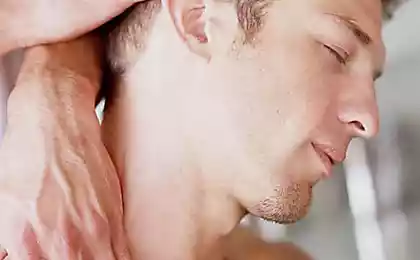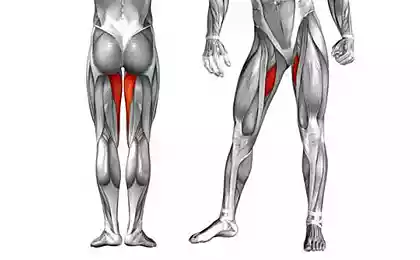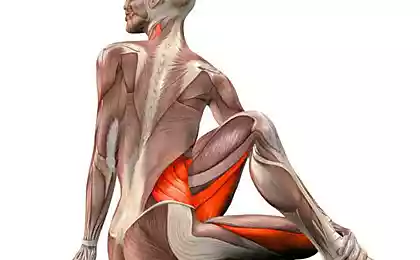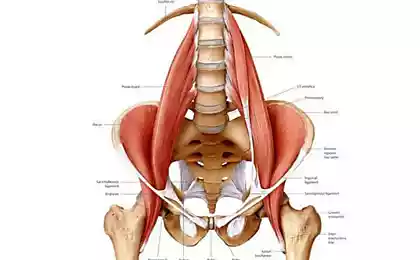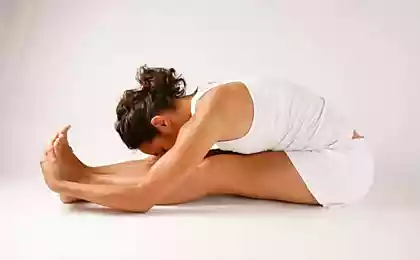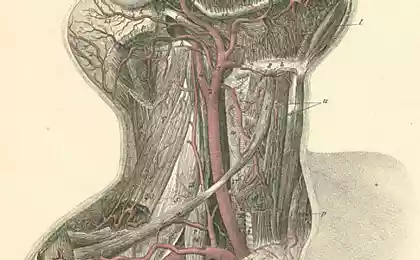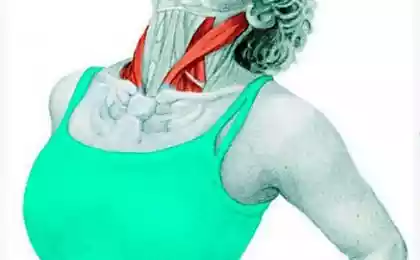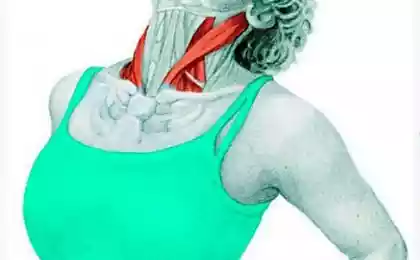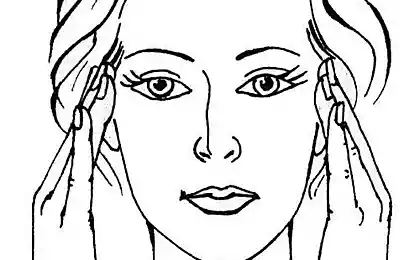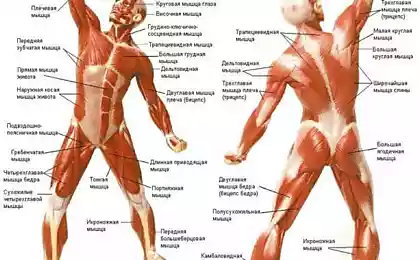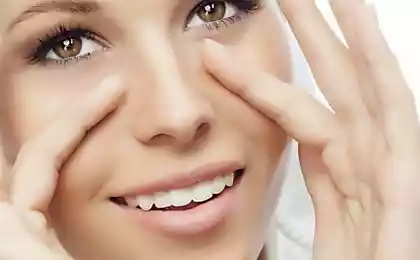514
The extensors of the neck, postisometric relaxation of the occipital-vertebral muscles
OCCIPITAL-VERTEBRAL MUSCLES are Short small and a large back straight muscles of the head are deep in the neck muscles connecting the I and II cervical vertebrae with the occipital bone. In bilateral contraction of these muscles, the head is bent backward, with one-sided, backward and sideways. Movement occurs only in the cervical-occipital joint.
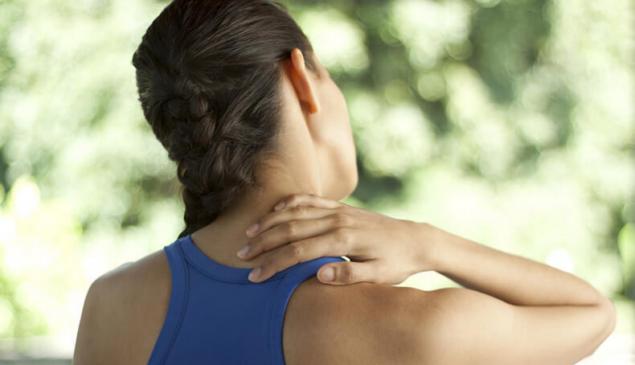
Painful muscle sealing the deep extensors of the neck can be felt in the cervical-occipital joint in the supine position with passively tilted backwards (for example, hang down from the edge of the bed) head.
To stretch these muscles sit on a chair with a high back, put his head in hands so that your thumbs lay on the cheekbones (feel the bumps under the lower edge of the orbit), the index finger under the lower edge of the occipital bone and the other fingers supported the back of the head (Fig. 30, a). On the inhale look up, and gently press the back of his head on its supporting fingers. About 10 seconds and then lower your eyes on a slow exhale, leaning back back against the chair, relax the muscles of the neck and hands, tilt the head in the cervical-occipital joint down (Fig. 30, b).
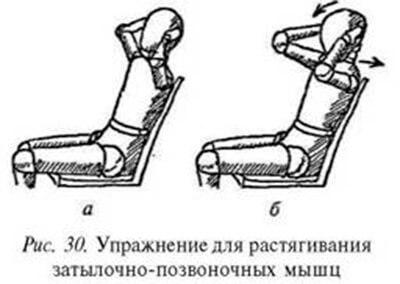
From the reached position, without raising his head, repeat the method several times until the maximum possible stretching of the muscles. The exercise can be performed several times a day.
You must make sure that did not occur flexion of the cervical spine, but only a motion in the cervical-occipital joint — nod. For this stronger push back on the chair and tilt the head down only with the hands, to relax the muscles of the neck.
The EXTENSORS of the NECK Many muscles in the back of the neck and upper back often experience an overload due to static electricity when you hold the head, especially with improper posture in a sitting position. People with weak muscles often develop their spasmodic contraction. Cervical lordosis thus strengthened, causing the head forward, like a turtle, and the trapezius muscle on the shoulder girdle is not concave down / stand up like a bodybuilder (Fig. 31, a).
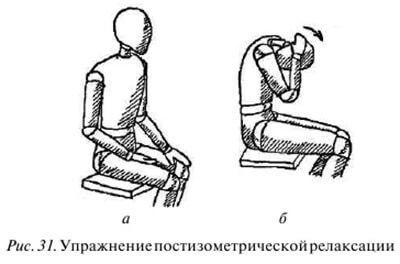
Disorders in the cervical spine often cause chronic cerebrovascular insufficiency, and as a result may be headaches, fainting and other symptoms. A pronounced spasm of the neck extensors does not allow you to touch the chin to chest in a straight position of the thoracic spine. With a slight shortening of the chin pulls to the chest only when bending the torso.
With the functional block of the joints of the spine, be sure to first remove the lock and only after that to proceed with the implementation of post isometric relaxation exercises.
Sit down, tilting the head forward and placing her hands with the clutch in the lock with your fingers on the back of the head. Torso and head need to stretch the muscles of the neck, not the back. On the inhale lift your eyes up, while the stretched muscle will reflexively tense up. On the exhale, relax your muscles and let the head is still a little lean (Fig. 31, b). Put pressure on the head should not be — to stretch the muscles enough weight hands. Reception is performed 3-5 times (cycles of inhale-exhale) or more.
Seizures — an IMPORTANT signal of the body serious violations
Massage language: who and why
Exercise should be perform for a long time, especially with habitual violation of posture. It is desirable also an exercise in stretching the upper part of the trapezius muscle.published
T. V. Lukyanenko "a Healthy spine. Recipes and recommendations"
Source: www.massage.ru/articles/postizometricheskaya-relaksaciya-zatylochno-pozvonochnye-myshcy

Painful muscle sealing the deep extensors of the neck can be felt in the cervical-occipital joint in the supine position with passively tilted backwards (for example, hang down from the edge of the bed) head.
To stretch these muscles sit on a chair with a high back, put his head in hands so that your thumbs lay on the cheekbones (feel the bumps under the lower edge of the orbit), the index finger under the lower edge of the occipital bone and the other fingers supported the back of the head (Fig. 30, a). On the inhale look up, and gently press the back of his head on its supporting fingers. About 10 seconds and then lower your eyes on a slow exhale, leaning back back against the chair, relax the muscles of the neck and hands, tilt the head in the cervical-occipital joint down (Fig. 30, b).

From the reached position, without raising his head, repeat the method several times until the maximum possible stretching of the muscles. The exercise can be performed several times a day.
You must make sure that did not occur flexion of the cervical spine, but only a motion in the cervical-occipital joint — nod. For this stronger push back on the chair and tilt the head down only with the hands, to relax the muscles of the neck.
The EXTENSORS of the NECK Many muscles in the back of the neck and upper back often experience an overload due to static electricity when you hold the head, especially with improper posture in a sitting position. People with weak muscles often develop their spasmodic contraction. Cervical lordosis thus strengthened, causing the head forward, like a turtle, and the trapezius muscle on the shoulder girdle is not concave down / stand up like a bodybuilder (Fig. 31, a).

Disorders in the cervical spine often cause chronic cerebrovascular insufficiency, and as a result may be headaches, fainting and other symptoms. A pronounced spasm of the neck extensors does not allow you to touch the chin to chest in a straight position of the thoracic spine. With a slight shortening of the chin pulls to the chest only when bending the torso.
With the functional block of the joints of the spine, be sure to first remove the lock and only after that to proceed with the implementation of post isometric relaxation exercises.
Sit down, tilting the head forward and placing her hands with the clutch in the lock with your fingers on the back of the head. Torso and head need to stretch the muscles of the neck, not the back. On the inhale lift your eyes up, while the stretched muscle will reflexively tense up. On the exhale, relax your muscles and let the head is still a little lean (Fig. 31, b). Put pressure on the head should not be — to stretch the muscles enough weight hands. Reception is performed 3-5 times (cycles of inhale-exhale) or more.
Seizures — an IMPORTANT signal of the body serious violations
Massage language: who and why
Exercise should be perform for a long time, especially with habitual violation of posture. It is desirable also an exercise in stretching the upper part of the trapezius muscle.published
T. V. Lukyanenko "a Healthy spine. Recipes and recommendations"
Source: www.massage.ru/articles/postizometricheskaya-relaksaciya-zatylochno-pozvonochnye-myshcy

